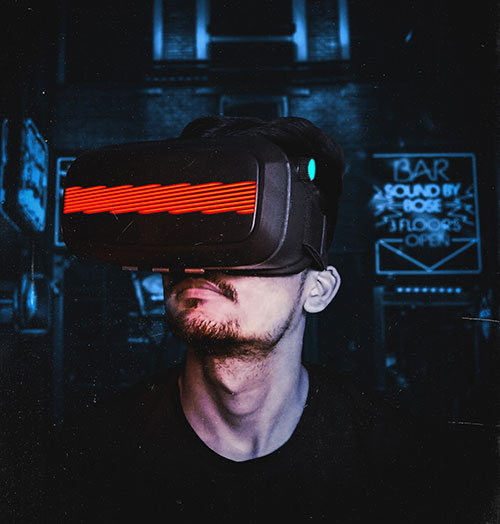
Aug 19, 2019
Blog Digital World Virtual Reality Technologies: An Industry Overview
Technology is constantly evolving and merging the lines between people, the internet and physical world. Virtual Reality (VR) is an example of a relatively new technology that has made a significant mark in the technology industry.
Virtual Technology can be defined as a “three-dimensional computer-generated environment created through the combination of hardware devices and software programs allowing users to interact with an artificial three-dimensional environment” (Virtual Reality Technologies: Global Market).
Development and research in virtual reality demonstrate that it is continuing to advance as technology improves. This advancement in the market is from the increasing mobile industry and presence of virtual reality in the automotive sector.
In a recent BCC Research webinar, “Transformative Learning and Enhanced Creativity Through the Use of Virtual Realities,” Fabio Montella, Assistant Professor of Library Services at Suffolk County Community College, discusses how virtual reality is one of the most contemporary and dynamic technologies used today.
Virtual Reality in the Global Market
Virtual reality technology in the market can be applied in healthcare, gaming, education, military, engineering and many more. A few major market participants are Samsung, Sony, HTC Vive, Alphabet (Google) and Oculus VR.
BCC Research Analysts found that the market value for global virtual reality technologies was $2.3 billion in 2016, predicted to grow at a CAGR of 60.5% and is estimated to reach $39.4 billion by 2022. The Asia-Pacific region has the largest market share for the global VR market, with North America and Europe behind.
What else is going on in VR?
Future Marketing Projections
Statistics have demonstrated that consumers are interested in using VR equipment and advanced technology. The technology industry is predicted to rise due to the VR headset devices from Facebook, Google and HTC.
The virtual reality market will also increase due to wireless technologies produced by companies like Qualcomm, AMD, Intel and Peraso that are creating WiGig chips for wireless VR solutions.
Virtual Reality in Education
The education sector is expected to become the most prominent application of VR. As Montella stated in the webinar, gaming is not the largest sector of VR, it’s education, which marked $63.8 million in 2016. In the coming period, VR will implement various new types of immersion and potential of learning for students.
Montella also notes that VR immerses students in apps by giving them control over it, particularly with anatomy and physiology apps, they can closely look at and maneuver eyes and hearts. Art professor, Meredith Starr, used VR in her drawing classes as well. One of her students quoted in the webinar “VR allows the opportunity to expose students to artists in a new way and allow students to get an inspiration and ideas for their own work.”
Additional VR market trends to watch:
Virtual Reality Market Restraints
Although there have been significant advancements in the VR market, components such as negative health effects, weak VR content, lack of VR familiarity and over-pricing are considerable factors that the virtual reality industry needs to overcome in order to be competitive in the market.
Health Effects of Virtual Reality
There are a few side effects – headaches, nausea and sore eyes – of virtual reality devices, which is a difficult component for companies to overcome in the long term.
Weak VR content
Lack of content is a big challenge for VR technology, which is inhibiting growth in the competitive market. Since technology is constantly evolving, it is difficult to keep up on this technology with new content. Not only do consumers contemplate on purchasing VR technology, but when large brands like Oculus and HTC are separated, the user must decide if they then want to buy a product from a smaller company that provides low quality content.
Lack of Familiarity and Pricing
Statistics in 2015 demonstrate that only 10% of people have decent knowledge on VR technology. Companies should advertise their products to consumers before they are released into the market. Also, VR products are out of price range for many VR users and only 20% of consumers are willing to invest a lot in VR technologies.
To learn more about the Virtual Reality market – particularly trends and products – download our recent market research report, “Virtual Reality Technologies: Global Markets to 2022.”

Daniella is our Academic Insights Strategist and a current senior at Bates College. She writes about challenges facing college students and tangible ways students can thrive in their academic and professional lives.

From smartphones to satellites, antennas play a vital role in enabling the seaml...

Introduction Artificial Intelligence (AI) and the Internet of Things (IoT) are r...

We are your trusted research partner, providing actionable insights and custom consulting across life sciences, advanced materials, and technology. Allow BCC Research to nurture your smartest business decisions today, tomorrow, and beyond.
Contact UsBCC Research provides objective, unbiased measurement and assessment of market opportunities with detailed market research reports. Our experienced industry analysts assess growth opportunities, market sizing, technologies, applications, supply chains and companies with the singular goal of helping you make informed business decisions, free of noise and hype.